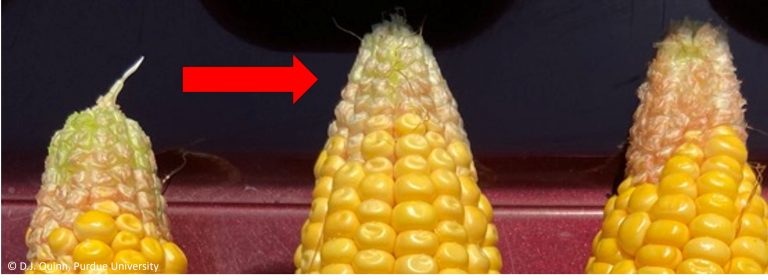Each year as corn harvest approaches and the anticipation for finally being able to get behind the wheel of the combine heighten, it is not uncommon to find work benches, dinner tables, and agronomist office desks full of corn ears. Examining corn ears from your fields each year can help provide an estimate of what the yield might be, however examining corn ears prior to harvest can also help paint the picture of how the corn plant was impacted throughout the year, and why your yield maybe wasn’t as good as you hoped.
One of the biggest concerns observed on corn ears examined in 2022 is that of “tip back”. Tip back can be described as corn ears that did not fill kernels from the base of the ear all the way to the tip of the ear, thus ear tips may exhibit some length of missing and/or incomplete kernels (Figure 1). There are two main reasons for tip back, which include 1) poor pollination, causing the absence of kernel formation and 2) kernel abortion. First, it is important to remember that the silks that emerge last from an ear during pollination and the kernels that fill last during grain fill are located on the tip of the ear. Therefore, any significant stresses exhibited shortly before pollination, during pollination, and shorty after pollination can negatively impact these “youngest” kernels. If many of your corn ears exhibit tip back, then examine the tips of the ears closely to understand the cause of the problem. Poor pollination can occur when stressful conditions occur a few weeks prior to and during pollination (e.g., silk and tassel emergence). For example, drought conditions can delay silk emergence and cause poor synchrony between pollen drop and silk emergence. In addition, since the last emerging silks are located at the tip of the ear, pollen drop (which occurs only for 7-10 days) can be completed prior to silk emergence, thus causing the ovules (potential kernels) at the tip of the ear to never be pollinated. In contrast to missing tip kernels caused by poor pollination, kernel abortion can be identified by shrunken and shriveled kernels on the tip of the ear. Kernel abortion is mainly caused by stresses that reduce plant photosynthetic output (e.g., drought, hail damage, nutrient deficiencies, foliar disease) during the first several weeks following pollination and through the R3 (milk) growth stage. Even consecutive days of cloudy weather can reduce plant photosynthesis enough to cause kernel abortion. Overall, any plant stresses that limit photosynthetically active leaf area or the photosynthetic “factory” of the corn plant, can cause tip fill problems in corn. One example of this were the June drought conditions observed in certain areas of Indiana in 2022, which coincided with the rapid growth phase of corn, and thus limited total plant photosynthetic output, or the total “factory”, needed for grain fill.
Now, is all tip back bad? Well, the answer is no, not always. For example, in certain years, ideal environmental conditions present during corn ear size formation (i.e., kernel row number from V6 to V8 and kernel number per row from V6 to a few weeks prior to pollination) may cause ear size to be larger than normal and causing tip back to appear despite high yield conditions. Therefore, if tip back is observed, it is still important to examine total kernel numbers per ear to understand the extent the potential yield impacted.




